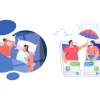Recent Posts
Most Popular
What is sadfishing and how does it threaten teens’ mental health?

When you notice a loved one looking sad and dejected and they are unlike their usual energetic and friendly self, you would go to them and ask them what the matter was. You would show your concern and give them your attention because you want to help make them feel better.
Imagine this other scenario. While scrolling through social media, you read your loved one’s sad and miserable posts. Because people are naturally social beings, and we have the ability to sympathize or empathize with other people’s pain, it is also natural for you to immediately give your loved one a call and ask them how they are, and what you can do to help them.
What if after calling them, they tell you that it was just posted for fun, and the situation was not as bad as they posted it on Instagram (IG) or Tiktok? They say they were just trying to see how much attention they would get from it.
How would you feel? Would you get annoyed? Or would you be concerned?
The above-mentioned situation is an example of a new term called “sadfishing.” It is a term recently made by writer Rebecca Reid to describe the act of seeking other people’s attention in a manipulative way through posting sad and personal stories on social media, predominantly on IG and Tiktok, and it is usually more common among young people.
The Boy Who Cried Wolf
In a fable written by Aesop, a shepherd boy lied a couple of times about the arrival of wolves who attack sheep in order to trick village people to come to his aid. But alas! When it was really true that wolves drew near to the sheep he guarded, nobody in the village believed in him telling the truth. The villagers got tired of giving him their time and attention because they thought he was just manipulating them again. And so, even though he really needed help this time, no one came to his aid.
This sadfishing trend is causing people to worry that those teens who are not coping well with stress, experiencing anxiety and are really asking for help might be ignored or dismissed as sadfishing.
We all want to be seen and heard.
In a time when teenagers are undergoing rapid development and maturing into young adults, they are more vulnerable to negative influences, but at the same time teens have very high potential to grow mentally and socially.
After the pandemic, there was a rise in symptoms showing a decline in mental health among teens such as anxiety, symptoms of depression, anger, and symptoms related to lack of social interactions.
In a 2023 study, published in the National Library of Medicine, researchers wanted to know what teenagers aged 11 to 17 years old to describe:
- their mental health needs,
- the risk factors affecting their mental health, and
- The red flags or signs that their mental health is in danger.
These teenagers said that their mental health needs are:
- Communication and support
- Self expression and freedom to make decisions
- A safe and personal environment.
Teens’ consider these as risk factors:
- Unhealthy social relationships, and
- Social media dangers.
There are mental health red flags according to teens:
- Self-exclusion from social life, and
- Self-destructive behavior.
One of the areas of vulnerability among teens is the negative influence of social media. Research has found a link between elevated screen time hours of teens to the rise of mental health issues in the US.
So is sadfishing a way for teens to seek the communication and support that they need? Probably. But it is also a sign for parents, caregivers and the community to assess how excessive social media exposure can lead to teens engaging in behaviors that further increase their stress and anxiety.
Instead of looking for sympathy online among strangers who might use teens’ sadfishing to lure teens into abusive and unhealthy relationships, teens have to be guided by their caregivers on healthier ways of self-expression. This includes caregivers making the home and their parent-child relationship as safe and welcoming as possible for communication to thrive so that teens learn to make real-life connections that really support them.
Check out the most extensive list of healthcare careers and connect with premier healthcare and mental health opportunities across the US.








Comments